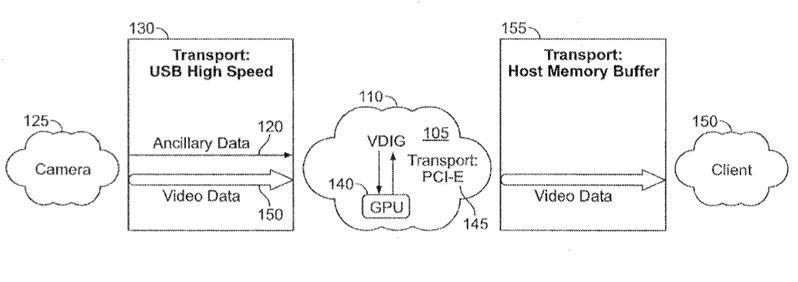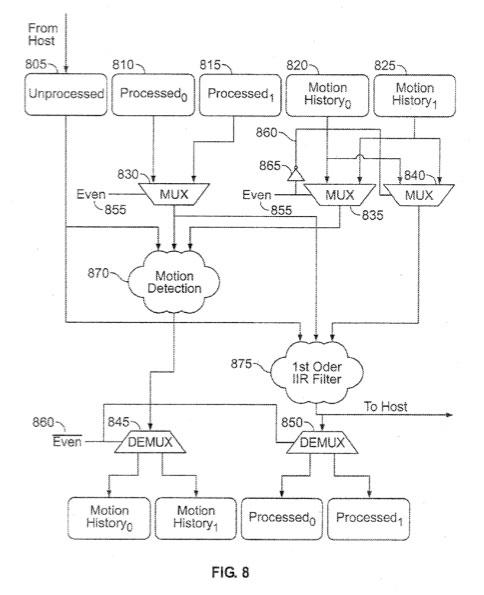A new patent application revealed this week, entitled "Video Acquisition with Processing Based on Ancillary Data," describes advanced techniques of processing video and improving picture quality. It describes plugging a camera or mobile device into a computer, which would then read "ancillary data" recorded by something such as an iPhone.
That data could be processed and used to help improve the image quality of the final product. Using the data, the computer could filter and/or blend the images, or use a whole range of other tools, to give even amateur videographers the best picture quality possible.
Features such as image stabilization have long been a feature of Apple's video editing tools, including Final Cut Pro and iMovie '09. But the newly described method would use sensors in a mobile device, like an iPhone, to improve picture quality even further.
The system could detect motion or a change in lighting conditions, and accordingly blend frames from the video to lessen the effect. But it could also employ less traditional methods, such as location and temperature, that could have an effect on picture quality.
"The image sensor and/or other components are subject to temperature outside of predetermined thermal specifications, which can cause some fixed pattern noise in the detected images," the application reads. "Such fixed pattern noise can show up as red and blue pixels at fixed locations that vary between sensors and can be exacerbated in low light and high heat."
The application states that charged-couple device (CCD) sensors provide a relatively high image quality, but are more expensive than complementary metal-oxide semiconductor sensors (CMOS). CMOS sensors also require less power, but produce a lower quality image than CCD sensors, particularly in low lighting.
"The described techniques and systems can be used to enable CMOS sensors to be used in place of relatively expensive CCD sensors, such as to achieve comparable quality from a CMOS sensor as from a CCD sensor," the application reads. "In particular, processing can be performed using software, hardware, or a combination of the two to filter out noise, which is increasingly present as light levels decrease; increase dynamic range; improve the overall image quality and/or color fidelity; and/or perform other image processing."
Revealed by the U.S. Patent and Trademark Office this week, the patent application was filed by Apple on May 3 of this year. The invention is credited to Alexei V. Ouzilevski, Fernando Urbina, Brett Bilbrey and Jay Zipnick.
 Neil Hughes
Neil Hughes








-m.jpg)






 Bon Adamson
Bon Adamson
 Marko Zivkovic
Marko Zivkovic
 Amber Neely
Amber Neely
 Malcolm Owen
Malcolm Owen


 Christine McKee
Christine McKee



-m.jpg)






26 Comments
Revealed by the U.S. Patent and Trademark Office this week, the patent application was filed by Apple on May 3 of this year. The invention is credited to Alexei V. Ouzilevski, Fernando Urbina, Brett Bilbrey and Jay Zipnick.
This is Old News.
The more interesting patent that Steve filed recently wansn't even reported here at AI.
Steve filed a patent that would allow him to brick any of his iPhones that he has detected has ever once been tampered with, including Jailbreaking. So the Jailbreakers will just have a lump of useless chrome and glass in their hands.
That is the greatest thing I ever heard.
http://www.zdnet.com/blog/apple/new-...n-iphones/8020
I don't know why AI chose not to report this good news. They usually report every patent application that Steve submits.
Certainly, knowing temperature improves video editing. Supposedly it even has positive impact on bugs of editing software and entire platform.
How about prespiration sensor for the person that makes video?I smell somewhat different purpose of this.
This is Old News.
The more interesting patent that Steve filed recently wansn't even reported here at AI.
Steve filed a patent that would allow him to brick any of his iPhones that he has detected has ever once been tampered with, including Jailbreaking. So the Jailbreakers will just have a lump of useless chrome and glass in their hands.
That is the greatest thing I ever heard.
http://www.zdnet.com/blog/apple/new-...n-iphones/8020
I don't know why AI chose not to report this good news. They usually report every patent application that Steve submits.
yes, just noticed that too.
https://www.eff.org/deeplinks/2010/0...eking-patent-0haven't read the patent over but this type of thing chills me just as much or more than what google is doing....
Apple could improve the quality enhancement features in its video editing software by interpreting a whole range of data acquired from sensors, including the location and temperature where the video was shot.
_maybe_ I can see how temperature can be used to clean up video, but that's a stretch as the encoding tends to clobber noise into a smudge. How much noise to clean up probably should be a judgement call. I don't know how location can help at all.
Recording motion data for additional processing later might be a good idea.
yes, just noticed that too.
https://www.eff.org/deeplinks/2010/0...eking-patent-0haven't read the patent over but this type of thing chills me just as much or more than what google is doing....
The EFF did a real hit job here.
This patent has nothing to do with jailbreaking, but rather theft.
Do you really think that they need to recognize the user's face to determine whether the phone was jailbroken or not? Apple can already tell whether your phone is jailbroken. A simple call home method (the kind Windows has been using since XP) would work equally well too.
And in fact, you know, there already is a phone and technology that can brick itself if you jailbreak it. Its called Motorola's eFuse, and is loaded on the Droid X (yeah, its an 'open' Android phone).
It currently does not brick the phone, but it has the capability (Moto hasn't enabled it) and already prevents you from loading different ROMs.
How come the EFF isn't up in arms against Dr. Sanjay Jha (Motorola CEO) about this?